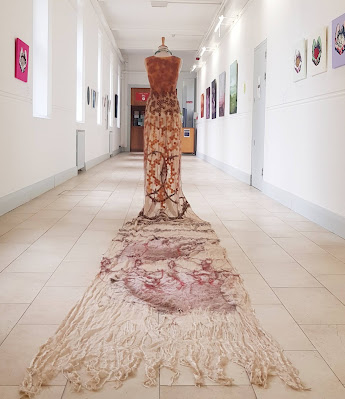* Crossing to the other shore
'Crossing to the other shore, (2021)' To understand the structures of society and human behaviour, many authors use the beehive as an anthropological analysis. In "The Hive: The Story of the Honeybee and Us (2004)", Bee Wilson notes that “the beehive has been, in turn, monarchical, oligarchic, aristocratic, constitutional, imperial, republican, absolute, moderate, communist, anarchist and even fascist. However, never democratic.” The piece "Crossing to the other shore, (2021)" is a textile latex structure imitating the perfect geometric shapes of the beehive. The cloth damaged, torn and creasing, it evokes the worn nations, deteriorated by patriarchal laws, conflicts and forced migrations. The choice of latex is due to the similarity of appearance it has with human tissue. Anne Hamlyn pointed out that the clothes are “surrogate skin, a body at one remove." The skin is the largest bodily organ. By using the animal's skin, metaphorically we use the animal's body to protect ours. Clothing as the second layer of the skin is more than a body covering. It is a medium of communication in our modern society. The cloth speaks to us and tells stories. The semi-transparent Jemina fabric used in this work is a blend of silk and cotton that is easy to manipulate. Its characteristics and ease of changing colour, texture and shape, have a certain similarity to human society. In the five meters of cloth, the story is told repeatedly, the exile and the suffering of migrants. Two exhausted hands try to reach freedom (the ‘free nation’) guarded by barbed wires that act as barriers. Even though their hands bleed, they don't lose hope. Little by little, inadvertently small machine-embroidered silhouettes appear shyly at the waist of the structure. It is the flow of people in searching for a better life. They are near to that ‘free nation’ that they have heard so many times in their home countries. The threads intertwine between them to narrate the pain suffered by the displaced as a result of conflicts that they neither started nor wanted. Many of them will not arrive and their identities will become a statistical number on the list of shipwrecked migrants. And those who make it to their destination will find that the ‘free nation’ is not what they heard or hoped for. The geometric shapes of the beehive that depict the nation, it isn't a ‘free nation’ it is just another nation with its structures, laws, and prejudices. The bureaucratic structures of this new nation are difficult to digest, which forces many to live in a clandestine way, under a shadow economy without resources or rights. Marginalized and excluded from a society they once dreamed of being part of.















Comments
Post a Comment